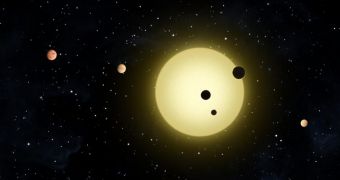According to investigators, it could be that galaxies including our own are permeated by runaway exoplanets. These are planets that formed normally, around their parent stars, but got kicked out of their respective star systems due to a variety of reasons.
Under one scenario, for example, gravitational interactions between planets can easily lead to the smaller one being kicked out of its previous orbit. If it does not manage to reestablish itself in a new orbit, then it flies out of its former system, and starts wandering through the galaxy.
We are very used to the idea that planets revolve around stars, but the truth is that there are very many such cosmic bodies that do not follow this simple rule. In fact, the new study suggests that at least several hundred thousand such worlds may exist in the Milky Way.
The team behind the research believes that such “planetary masses” may be very common, and say that the solar system itself may have lost one or two planets in its earliest days. That theory has yet to be confirmed, but the new data do make it more likely.
The study was carried out by scientists with the Kavli Institute for Particle Astrophysics and Cosmology (KIPAC), which is jointly operated by the Stanford University and the SLAC National Accelerator Laboratory.
Researchers here believe that this discovery has the potential to influence existing theories on planetary formation. The number of exoplanets we can potentially see in the galaxy is only a fraction of the true number of worlds out there.
All 750+ confirmed exoplanets and 3,200+ candidates are located in orbit around stars. The very reason they have been detected is because they passed between a telescope and their parent stars, or because they exert a strong gravitational pull on the larger celestial bodies.
But such effects are non-existent as they travel through the darkness of space, and existing telescopes are too primitive to see such cold worlds directly. This could potentially be addressed with the launch of Hubble's replacement, the James Webb Space Telescope (JWST).
But the new study may have also proved the existence of a previously unknown environment for life to develop. “If any of these nomad planets are big enough to have a thick atmosphere, they could have trapped enough heat for bacterial life to exist,” KIPAC expert and study leader Louis Strigari concludes.
Researchers published a paper describing the findings in the latest issue of the esteemed scientific journal Monthly Notices of the Royal Astronomical Society, Space reports.

 14 DAY TRIAL //
14 DAY TRIAL //